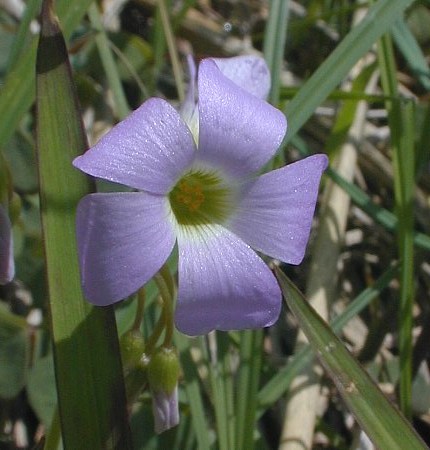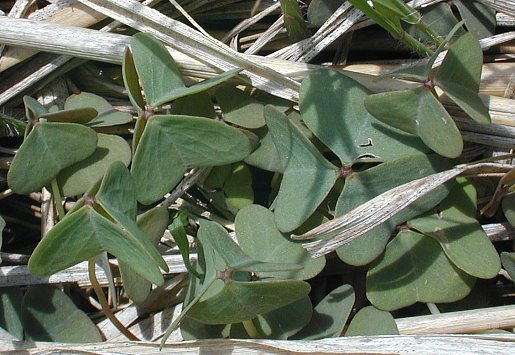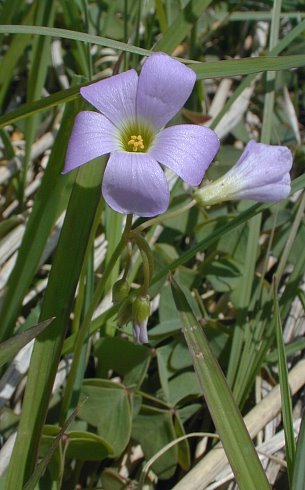Description: This perennial plant is up to 6" tall. It consists of a small cluster of trifoliate basal leaves on long petioles that emerge directly from the ground. The petioles of the basal leaves are up to 4" long; they are whitish green to pale reddish green, terete, glabrous, and rather delicate in appearance. Individual trifoliate leaves are about 1" across and they open up during the day. Each leaf consists of three obcordate leaflets with smooth margins. The leaves may turn purplish in response to cold weather or strong sunlight, otherwise, they tend to be greyish green. Both the upper and lower leaflet surfaces are hairless.

Among these leaves, floppy umbels of flowers develop on peduncles up to 6" long. The peduncles are similar in appearance to the petioles. Each umbel has 2-5 flowers on slender pedicels up to 1" long; usually only 1-2 flowers per umbel are in bloom at the same time. The flowers are bell-shaped (campanulate) and about 1/3" (8 mm.) across. Each flower has 5 lavender or pale purple petals, 5 light green sepals, 5 inserted stamens with yellow anthers, and an ovary with an inserted style. Near the throat of the flower, the petals become greenish white with converging fine veins; they are oblanceolate in shape, often becoming slightly recurved toward their tips. The sepals are shorter than the petals; they are lanceolate in shape and hairless with purplish tips. The blooming period occurs from mid-spring to early summer, lasting about 1-2 months. On rare occasions, Violet Wood Sorrel may bloom again during the fall. There is no floral scent. Eventually, slender pointed seed capsules develop that split into 5 sections, sometimes ejecting the light brown seeds several inches. The root system consists of small bulblets with fibrous roots; these bulblets can multiply by forming clonal offsets.
Cultivation: The preference is full to partial sun and mesic to dry conditions. The soil can be rocky or loamy. Disease is not normally a problem as long as the site is well-drained. Violet Wood Sorrel can be cultivated in gardens if taller and more aggressive vegetation is kept away.

Range
& Habitat:
The native Violet Wood Sorrel occurs in every county of Illinois (see Distribution
Map). It is occasional throughout the state. Habitats include
mesic to dry black soil prairies, hill prairies, open upland forests,
savannas, edges of wooded bluffs, limestone glades, and abandoned
fields. Violet Wood Sorrel responds positively to prairie wildfires as
this clears away the dead vegetation that can smother this plant during
the spring. It is usually found in higher quality natural areas where
the original ground flora has been left intact.
Faunal Associations:
Primarily long-tongued and short-tongued bees visit the
flowers for nectar or pollen. This includes little carpenter bees (Ceratina spp.),
cuckoo bees (Nomada spp.),
mason bees (Osmia spp.,
Hoplitis spp.),
Andrenid bees, and Halictid bees (including green metallic bees). Less
commonly, the flowers may be visited by small
butterflies, skippers, and bee flies. Syrphid flies also visit
the flowers, but they feed on the pollen and are non-pollinating. The
oligophagous caterpillars of a brownish Noctuid moth, Galgula partita
(The Wedgling), feed on the leaflets of Oxalis spp. The
seeds of Oxalis spp.
are eaten to a limited extent by several upland gamebirds and
songbirds, including the Bobwhite, Mourning Dove, Horned Lark, Field
Sparrow, Grasshopper Sparrow, Savannah Sparrow, and Slate-Colored
Junco. The Prairie Deer Mouse and White-Footed Mouse also eat the seeds
of these plants. The Cottontail Rabbit browses on the foliage
occasionally, even though it is mildly toxic because of the presence of
oxalic acid.

Photographic
Location:
The photographs were taken at Loda Cemetery Prairie in Iroquois County,
Illinois.
Comments:
In Illinois, this is the only Oxalis
sp. (Wood Sorrel) that has lavender or pale purple
flowers. Other Wood Sorrel species within the state have yellow
flowers. Both the flowers and leaves open up on sunny days, otherwise
they fold up and "go to sleep." Violet Wood Sorrel is an attractive
plant, although rather small in size. The leaflets are supposed to be
edible in small amounts.